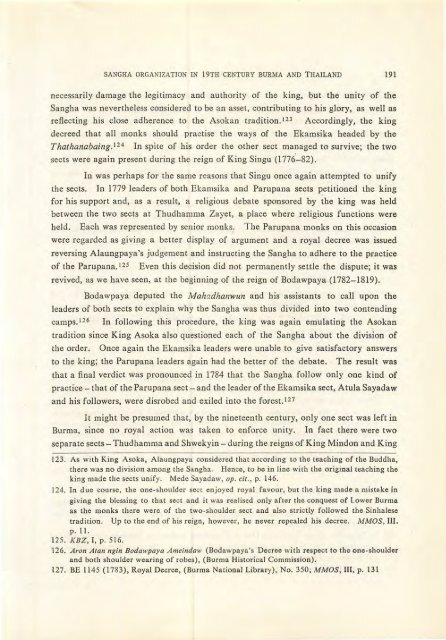The Journal of the Siam Society Vol. LXXII, Part 1-2, 1984 - Khamkoo
The Journal of the Siam Society Vol. LXXII, Part 1-2, 1984 - Khamkoo
The Journal of the Siam Society Vol. LXXII, Part 1-2, 1984 - Khamkoo
Create successful ePaper yourself
Turn your PDF publications into a flip-book with our unique Google optimized e-Paper software.
SANGHA ORGANIZATION IN 19TH CENTURY BURMA AND THAILAND 191<br />
necessarily damage <strong>the</strong> legitimacy and authority <strong>of</strong> <strong>the</strong> king, but <strong>the</strong> unity <strong>of</strong> <strong>the</strong><br />
Sangha was never<strong>the</strong>less considered to be an asset, contributing to his glory, as well as<br />
reflecting his close adherence to <strong>the</strong> Asokan tradition.l23 Accordingly, <strong>the</strong> king<br />
decreed that all monks should practise <strong>the</strong> ways <strong>of</strong> <strong>the</strong> Ekamsika headed by <strong>the</strong><br />
Thathanabaing.l 24 In spite <strong>of</strong> his order <strong>the</strong> o<strong>the</strong>r sect managed to survive; <strong>the</strong> two<br />
sects were again present during <strong>the</strong> reign <strong>of</strong> King Singu (1 7"76--82).<br />
In was perhaps for <strong>the</strong> same reasons that Singu once again attempted to unify<br />
<strong>the</strong> sects. In 1779 leaders <strong>of</strong> both Ekamsika and Parupana sects petitioned <strong>the</strong> king<br />
for his support and, as a result, a religious debate sponsored by <strong>the</strong> king was held<br />
between <strong>the</strong> two sects at Thudhamma Zayet, a place where religious functions were<br />
held. Each was represented by senior monks. <strong>The</strong> Parupana monks on this occasion<br />
were regarded as giv ing a better display <strong>of</strong> argument and a royal decree was issued<br />
reversing Alaungpaya's judgement and instructing <strong>the</strong> Sangha to adhere to <strong>the</strong> practice<br />
<strong>of</strong> <strong>the</strong> Parupana.t25<br />
Even this decision did not permanently settle <strong>the</strong> dispute; it was<br />
revived, as we have seen, at <strong>the</strong> beginning <strong>of</strong> <strong>the</strong> reign <strong>of</strong> Bodawpaya (1782-1819).<br />
Bodawpaya deputed <strong>the</strong> Mahadhanwun and his assistants to call upon <strong>the</strong><br />
leaders <strong>of</strong> both sects to explain why <strong>the</strong> Sangha was thus divided into two contending<br />
camps.t2 6<br />
In following this procedure, <strong>the</strong> king was again emulating <strong>the</strong> Asokan<br />
tradition since King Asoka also questioned each <strong>of</strong> <strong>the</strong> Sangha about <strong>the</strong> division <strong>of</strong><br />
t he order.<br />
Once again <strong>the</strong> Ekamsika leaders were unable to give satisfactory answers<br />
to <strong>the</strong> king; <strong>the</strong> Parupana leaders again had <strong>the</strong> better <strong>of</strong> <strong>the</strong> debate.<br />
<strong>The</strong> result was<br />
that a final verdict was pronounced in 1784 that <strong>the</strong> Sangha follow only one kind <strong>of</strong><br />
practice- that <strong>of</strong> <strong>the</strong> Parupana sect- and <strong>the</strong> leader <strong>of</strong> <strong>the</strong> Ekamsika sect, Atula Sayadaw<br />
and his followers, were disrobed and exiled into <strong>the</strong> forest.l27<br />
It might be presumed that, by <strong>the</strong> nineteenth century, only one sect was left in<br />
Burma, since no royal action was taken to enforce unity. In fact <strong>the</strong>re were two<br />
.separate sects- Thudhamma and Shwekyin- during <strong>the</strong> reigns <strong>of</strong> King Mindon and King<br />
123. As with King Asoka, A laungpaya considered that according to <strong>the</strong> teaching <strong>of</strong> <strong>the</strong> Buddha,<br />
<strong>the</strong>re was no division among <strong>the</strong> Sangha. Hence, to be in line wi th <strong>the</strong> original teaching <strong>the</strong><br />
king made <strong>the</strong> sects unify. Mede Sayadaw, op. cit., p. 146.<br />
124. In due course, <strong>the</strong> one-shoulder sect enjoyed royal favour, but <strong>the</strong> king made a mistake in<br />
giving <strong>the</strong> blessing to that sect and it was realised only after <strong>the</strong> conquest <strong>of</strong> Lower Burma<br />
as <strong>the</strong> monks <strong>the</strong>re were <strong>of</strong> <strong>the</strong> two-should.:r sect and also strictly followed <strong>the</strong> Sinhalese<br />
tradition. Up to <strong>the</strong> end <strong>of</strong> his reign, however, he never repealed his decree. MMOS, III.<br />
p. ll.<br />
125. KBZ, I, p. 516.<br />
126. Aron Atan ngin Bodawpaya Ameindaw (Bodawpaya's Decree with respect to <strong>the</strong> one. shoulder<br />
and both shoulder wearing <strong>of</strong> robes), (Burma Historical Commission).<br />
~27 . BE 1145 (1783), Royal Decree, (Burma National Library), No. 350; MMOS, IH, p. 131

















